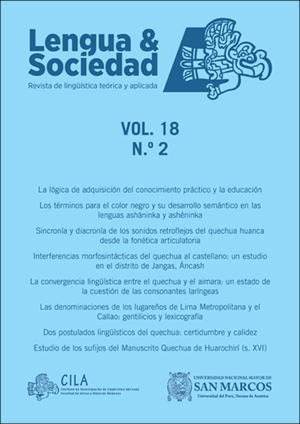The linguistic convergence between Quechua and Aymara: a state of the question of the laryngeal consonants
DOI:
https://doi.org/10.15381/lengsoc.v18i2.22331Keywords:
Language contact, Quechua-aru relationship, linguistic convergence, genetic kinship, laryngeal consonantAbstract
Andean historical linguistics has been responsible for determining whether the laryngeal consonants of southern Aymara are native to Quechua or Aymara. In this sense, knowing the origin of these consonants is taken as a criterion that adds to the clarification of the debate that exists between these two languages, with respect to the grammatical and lexical similarities that they present. Within this debate, two positions are noted: that of genetic kinship and that of linguistic convergence. In this sense, from the bibliographic review of these studies, in this article, I evidence that linguistic convergence is the position that has more reliable data. In summary, from this literature review, I provide an outline of the state of the matter of the laryngeal consonants of the southern Aymara.
References
Adelaar, W. (1986). La relación quechua-aru: perspectivas para la separación del léxico. Revista Andina, 4(2), 379-399. [Con comentarios: p. 400-426]
Adelaar, W. (2010). Trayectoria histórica de la familia lingüística quechua y sus relaciones con la familia lingüística aimara. Boletín de Arqueología PUCP, 14, 239-254
Cerrón-Palomino, R. (2000). Lingüística aimara. Cusco, Perú: CBC - Centro de Estudios Regionales Andinos «Bartolomé de Las Casas».
Cerrón-Palomino, R. (2013). Las lenguas de los incas: el puquina, el aimara y el quechua. Frankfurt, Alemania: Academic Research.
Hardman, M. (1983). Jaqaru: compendio de estructura fonológica y morfológica. Lima, Perú: Instituto de Estudios Peruanos - Instituto Indigenista Interamericano.
Hardman, J., Vásquez, J, Yapita, J., y et al. (2001). Aymara: compendio de estructura fonológica y gramatical. Recuperado de https://www.academia.edu/27864890/aymara_compendio_de_estructura_fonol%c3%93gica_y_gramatical
Huayhua, F. (2001). Gramática descriptiva de la lengua aimara (aymara aru yatiwi). Lima, Perú: Negocios Arco Iris.
Lovón, M. (2009). Hacia una teoría de la complejidad: estudio etnolingüístico y cognitivo de la correlación entre los platos típicos tupinos y su construcción lexical en la lengua jaqaru (Tesis de licenciatura). Universidad Nacional Mayor de San Marcos, Lima, Perú.
Moreno, F. (1999). El estudio de la convergencia y la divergencia dialectal. Revista Portuguesa de Filología, 23(1), 1-27. Recuperado de https://www.researchgate.net/publication/282980330_el_estudio_de_la_convergencia_y_la_diver-gencia_dialectal
Oliva, D. (2006). El cauqui: documentación y descripción fonológica de una lengua moribunda (Tesis de licenciatura). Pontificia Universidad Católica del Perú, Lima, Perú.
Orr, C., y Longacre, R. (1968). Proto-quechumaran. Language, 44(3), 528-55.
Park, H., y Kim, H. (2015). Acoustic characteristics of aymara ejectives: a pilot study. Researchgate. Recuperado de https://www.researchgate.net/publication/282154445_acoustic_characteristics_of_aymara_ejectives_a_pilot_study
Torero, A. (2002). Idiomasde los Andes: lingüística ehistoria. Lima, Perú: Horizonte.
Downloads
Published
Issue
Section
License
Copyright (c) 2019 Nick Bryan Sandoval Zapata

This work is licensed under a Creative Commons Attribution 4.0 International License.
AUTHORS RETAIN THEIR RIGHTS
a. Authors retain their trade mark rights and patent, and also on any process or procedure described in the article.
b. Authors can submit to the journal Lengua y Sociedad, papers disseminated as pre-print in repositories. This should be made known in the cover letter.
c. Authors retain their right to share, copy, distribute, perform and publicly communicate their article (eg, to place their article in an institutional repository or publish it in a book), with an acknowledgment of its initial publication in the journal Lengua y Sociedad.
d. Authors retain theirs right to make a subsequent publication of their work, to use the article or any part thereof (eg a compilation of his papers, lecture notes, thesis, or a book), always indicating its initial publication in the journal Lengua y Sociedad (the originator of the work, journal, volume, number and date).



























